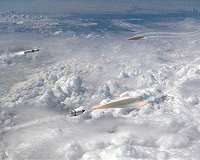Pentagon to Test Hypersonic Missiles at Five Times the Speed of Sound
The Pentagon plans a “very aggressive” expansion of its hypersonic weapons efforts this year, with at least four initial flight tests of prototypes for glide bombs that can fly five times the speed of sound and maneuver en route, officials said.
A new Hypersonics Transition Office that Congress funded this year will also bankroll a university consortium to conduct advanced research into the weapons and develop a workforce for the new technology, the officials said.
Defense Secretary Mark Esper said on Friday that the next Pentagon budget proposal will increase funding beyond the $5 billion provided in this year’s five-year budget plan for the technology that he called a key part of the “great-power competition” with China.
“We have significantly ramped up flight testing and other experimentation so that we can accelerate the delivery of this capability -- in all its forms -- to our warfighters years earlier than previously planned,” Esper said.
Michael Griffin, the undersecretary of defense for research and engineering, told a congressional committee in 2018 that China has conducted 20 times as many hypersonic tests as the U.S. In addition, Russia claims to have fielded a hypersonic boost-glide nuclear warhead for its SS-19 intercontinental ballistic missiles.
The weapons were elevated to the Pentagon’s top research and development program in 2017, but until now the effort has been limited to development prior to flight testing.
Lockheed, Raytheon
“By the end of the year we will have flown at least four times with different concepts,” Mike White, the Defense Department’s assistant director for hypersonics, said in an interview.
“This year will mark the transition of our development program” as concepts “have been matured” through ground testing and the design process, White said. “We have plans to fly prototypes for land-, sea- and air-launched concepts being developed across our portfolio.” He said
Lockheed Martin Corp. and
Raytheon Co. are developing the projects as the prime contractors.
Mark Esper
Photographer: Chris Kleponis/Pool via Bloomberg
“We need to be flying often,” added Mark Lewis, the Pentagon’s director of research and engineering. “We need to be willing to fail” and “test again, learn from those experiences.”
He said the hypersonic weapons “are hard to stop, they can maneuver, they’re unpredictable” and “hard to detect” so “you don’t have a lot of time” to respond. Some of the weapons may travel beyond the earth’s atmosphere or be sent from space after separating from a rocket launched from Earth.
The Navy, Army and Air Force as well as the Pentagon’s advanced research agency are all developing prototype weapons.
Pacific-Based Force
The Army, for example, is developing a “Long-Range Hypersonic Weapon” that service Secretary Ryan McCarthy said might be deployed with a new Pacific-based task force capable of conducting electronic, cyber, information and missile operations against China.
In addition to Lockheed and Raytheon,
Northrop Grumman Corp. and closely-held
Dynetics Inc. are all developing weapons or key components. The Pentagon hasn’t yet committed yet to procuring their products.
The Congressional Research Service has cautioned that Congress “might consider a number of questions about the rationale for hypersonic weapons.” The issues include “their expected costs, and their implications for strategic stability and arms control,” the nonpartisan agency said in September.
The university consortium that’s being formed will tap into universities already making some investments in hypersonics. Lewis said it could include Purdue, Notre Dame, Texas A&M, and the University of Minnesota. The consortium will receive a “significant portion” of $100 million Congress approved this year when it created the Transition Office, White said.
— With assistance by Roxana Tiron


 www.thedrive.com
www.thedrive.com
















